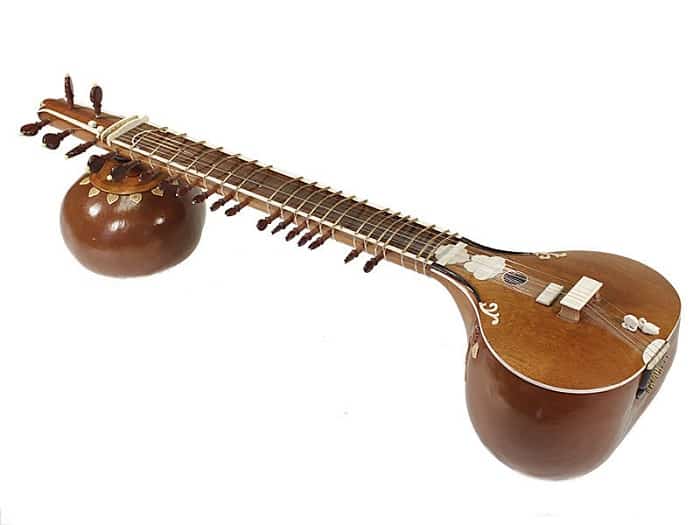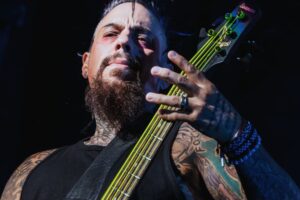The sitar and the guitar are both stringed instruments. You have to strum or pluck their strings to produce the sound from the instrument. The sitar has a very unique tone that is quite different from the sound of a guitar. It is primarily used in the East, particularly in India and in other countries in South Asia.
The tone of the guitar is well-known all over the world. It was popularized in the West by modern pop stars and was adopted in almost all the countries in the world.
You will not mistake the sound of a guitar from other stringed instruments like the piano, the banjo, the violin, and the electric bass. The sound of the sitar is definitely different from the sound of a guitar.
Sitar vs. Guitar: What is the difference? Which one should you choose to learn? Choose to learn the sitar if you want to play traditional Indian or Eastern music. It will also be the right stringed instrument if you want to create unique Western-style music. The guitar is your instrument of choice if you want to play Western music like rock, folk, classical, jazz, blues, and pop.
The sitar was born in a place that is quite different from the place where the guitar was born. That difference played a major role in the distinct sounds that these instruments produce.
Read on to learn more of the differences between the sitar and the guitar, including their individual features.
Also, for an excellent sitar, take a look at our top pick, the Indian Handmade Electric Sitar Shri Ravi Shankar Style:
Click here to see it on Amazon.
Sitar vs Guitar
There are a lot of distinct differences between the sitar and the guitar. The most noticeable is the sound that they make. Another one is their shape. The way these instruments are stringed is very different from each other.
To help you get a better grasp of how they differ from each other, I have created a simple table that will spell out their most notable differences.
| SITAR: | GUITAR: | |
| Shape: | The shape of the resonating chamber is like a gourd. Its neck is much longer than a guitar neck. | The shape of the resonating chamber of the standard guitar is like a woman’s torso, with a slender waist. Its neck is shorter than a sitar’s neck. |
| Number of Strings: | The strings of a sitar can be 18, 19 or 20. Six to seven of these strings are played while the rest are sympathetic strings. The played strings run over the curved and raised frets. The sympathetic strings run under the frets. They resonate when the played strings are plucked or strummed. | There are only six strings in a standard guitar. But there are also 12-stringed and 18-stringed guitars. |
| Sound: | The gourd produces a unique timber sound when the strings are strummed or plucked. | The sound is produced acoustically in an acoustic guitar and by electrical amplification in an electric guitar. |
| Types: The sitar is available in three different styles: instrumental style, full decorated “instrumental style,” and “gayaki style.” There are three main styles of guitars: the classical guitar with nylon strings, the acoustic guitar with steel strings, and the electric guitar. | ||
| Position of Strings: | The strings on a sitar are placed in different heights or levels. The 6 ‘chord strings’ are placed on top of the frets. These are the strings that are played. The rest of the strings are placed below the frets. They cannot be pressed. | The strings in a guitar are all placed on the same height or level. All these string can be played. |
| Playing Position: | The most common position to play the sitar is the sitting (cross-legged) position. | The compact construction of the guitar makes possible all kinds of playing positions. You can play it even while you are lying down on your back. |
| String Characteristics: | In a sitar, only two strings can play the melody. The location of the rest of the strings makes it hard for them to carry the melody line of a music piece. | All the strings in a guitar can play the melody |
| Fret Setup: | The sitar frets hover above the neck, just like a bridge hovers above the river. | The guitar frets are installed or set in their right intervals right on top of the neck. They are ‘planted’ on the neck of the guitar. |
What Is a Sitar and How Is It Different from a Guitar?

The sitar is basically a chordophone, which is a musical instrument that produces sound by vibrating the strings that are stretched between two points. This bowl-shaped lute is closely linked to the North Indian classical music known as Hindustani. Many people in several countries in South Asia, including Nepal, Afghanistan, Bangladesh, and Pakistan, also play this instrument.
Its Construction is Different and Complex
The construction of the sitar is quite complex. It is composed of many parts. I will just list here the main parts that make the sitar a unique instrument.
- It has a large bowl-shaped resonator called Tabli, which functions as the main soundboard. Traditionally, sitars were made from teak wood. Now, modern manufacturers use carbon fiber to build them.
- The body of the sitar is called Kadu Ka Tumba. It is usually made of big dried gourd. You must be careful in handling this material because it is very fragile. Nowadays, they can be made from carbon fiber as well to protect them from accidental damages.
- Dandi, the neck of the sitar is hollow. This helps in the production of the sound because it adds to the resonation of the instrument. Dandis are usually made of one piece of teak wood.
- The main bridge of the sitar is called Bada Ghoraj. Traditionally, they are made from the bones of animals. Nowadays, they can be made from synthetic materials like polyoxymethylene plastic.
You Can Only Play It Sitting Down
The only position you can play the sitar is the cross-legged sitting position. You should have the base of the instrument sitting on the floor. The neck should be tilted upwards at a 45° angle. Like the guitar, you need to have the neck and the frets facing away from you. You should also have your right forearm resting on the gourd. Then, put a wire plectrum on the tip of your right index finger and start to pluck the main strings, not the sympathetic strings.
The Sitar Has a Fascinating History
The Persian setar is the original version of the modern sitar. Setar means ‘three-stringed instrument.’ Records show that this instrument was introduced into the Hindu culture in the 13th century. It is uncertain how the word ‘setar’ evolved into ‘sitar.’
At the start of the 18th century, the sitar has established itself as a long-neck three-stringed lute. Over time, there were many modifications done on the instrument by inventive luthiers. They added more melody strings and more frets to the neck.
The chikari strings were added in the mid-19th century. Later, at the end of the 19th century, the taraf strings were also added to the sitar. Most of the sitars you can see in the East today have this style of construction.
The Sitar’s Introduction to Western Pop Culture
The droning sound of the sitar was first heard on the record “See My Friends” by the Kinks in 1960. Then the Yardbirds’ record “Heart Full of Soul” has a sitar playing the main riff. It was a hired sitar player who played it.
Then the Beatles recorded their “Norwegian Wood (This Bird Has Flown)” in 1965. That was the first record that brought the sitar to the attention of Western pop music fans. George Harrison played the sitar. He was the first pop star to play the sitar on a successful commercial record. As they would say, the rest is history.
Harrison and the Beatles went on to record many songs, with the sitar playing a major part. From their album “Help” to “Sgt. Pepper’s Lonely Hearts Club Band” to the records “Across the Universe and “Tomorrow Never Knows,” the Beatles influenced major musicians of major recording companies to take up the sitar and make it one of their equipment.
Harrison learned to play the sitar from Ravi Shankar, a famous Indian sitarist. Even the Rolling Stones’ Brian Jones used the sitar in some of their recordings. You will hear the instrument in the Stones’ “Paint it Black” record. Even Jimi Hendrix did a recording session with the Stones in 1967 when they recorded “My Little One” in which Brian Jones played the sitar.
Recommended Sitars
If you are interested in buying a sitar of good quality and at affordable prices, you can check out the listings at Amazon.
If you want a modern sitar, you can consider the Indian Handmade Electric Sitar Shri Ravi Shankar Style.
Click here to see it on Amazon.
This sitar is made from tun wood, is equipped with a pick-up, and comes with a bag. It is made with professional quality and is adorned with a beautiful flower design.
Another excellent sitar is the Sala Persian Quality Sitar:
Click here to see it on Amazon.
The bowl of this affordable but quality sitar is made of Mulberry. Its neck is made of Walnut, which is also the material used for its pegs. The overall length of the sitar is 86 cm. Each string is 66 cm. long. It comes with a soft bag and some extra strings.
Recommended Guitars
There are so many guitars to choose from. One of the best acoustic-electric guitars for beginners is the Taylor GS Mini-e Walnut/Spruce Acoustic-Electric Guitar.
Click here to see it on Amazon.
Taylor GS Mini’s scaled-down size is extra portable and has the great sound of a larger guitar. The shorter 23-1/2 in. scale length makes forming chords a breeze yet gives the instrument plenty of snap and tuning stability for a rewarding and easy playing experience.
If you want a more affordable guitar with all the accessories included, go for the Fender CD-60SCE Dreadnought Acoustic-Electric Guitar.
Click here to see it on Amazon.
Combining powerful onboard electronics — including a built-in tuner — with great tone and easy playability, the Fender CD-60SCE is ideal for beginning to intermediate level players. It is an affordable kit that includes a tuner, gig bag, strap, picks, strings, and cloth.
Is It Easy to Learn Sitar If You Know How to Play the Guitar?

The straight and simple answer is no. It is possible to pick up a sitar and jam around on it if you already play guitar. To the sitar-untrained ear, you may sound convincing. But if a decent sitar player hears you, they will not be able to understand what you are doing.
Playing the sitar is not just about learning the technique. Maybe this will help you understand the concept: if music is a pool, and the deep end is Indian classical music, then Western music is the small puddle outside the locker room.
When Indian sitarists play their sitars, they don’t play it as Western guitarists play their instruments. Western guitarists play straight notes and then ornament those notes at opportune times in their music. Indian sitarists don’t just play straight notes; they ornament everything. They do this often with microtones. Some say they are playing between notes instead of playing the notes.
It will take you a lot of practice before you can play Indian sitar the way it should be played. Ravi Shankar, the teacher of George Harrison, spent ten hours a day practicing for seven years every day before he was considered a good sitar player. A lot of people practice for five years before they perform in public.
If you are already proficient in playing the guitar, it is entirely possible to play the sitar. Look at the examples of George Harrison and other professional Western musicians. But you need a lot of patience, hard work, and perseverance.
For one, sitting for hours playing an instrument is something that you must get used to. Your knees may hurt after a few minutes sitting cross-legged. Some have experienced pain in their joints after practicing the sitar for a few hours.
If your intention is not to be a master of sitar playing but just to be able to play it decently and in order, then it would be a worthy goal. Some are doing this because they want to enrich their musical know-how and experience.
Indian classical music, of which the sitar plays a major role, is entirely different from Western classical music, or Western music for that matter. Learning and appreciating it is something that can make musically inclined individuals happier and more fulfilled.
If you really fell in love with the sitar, all these obstacles will be nothing. They are just some of the usual things that can block the artist in you. Persevere and let your talent overcome these difficulties.
Read next:













